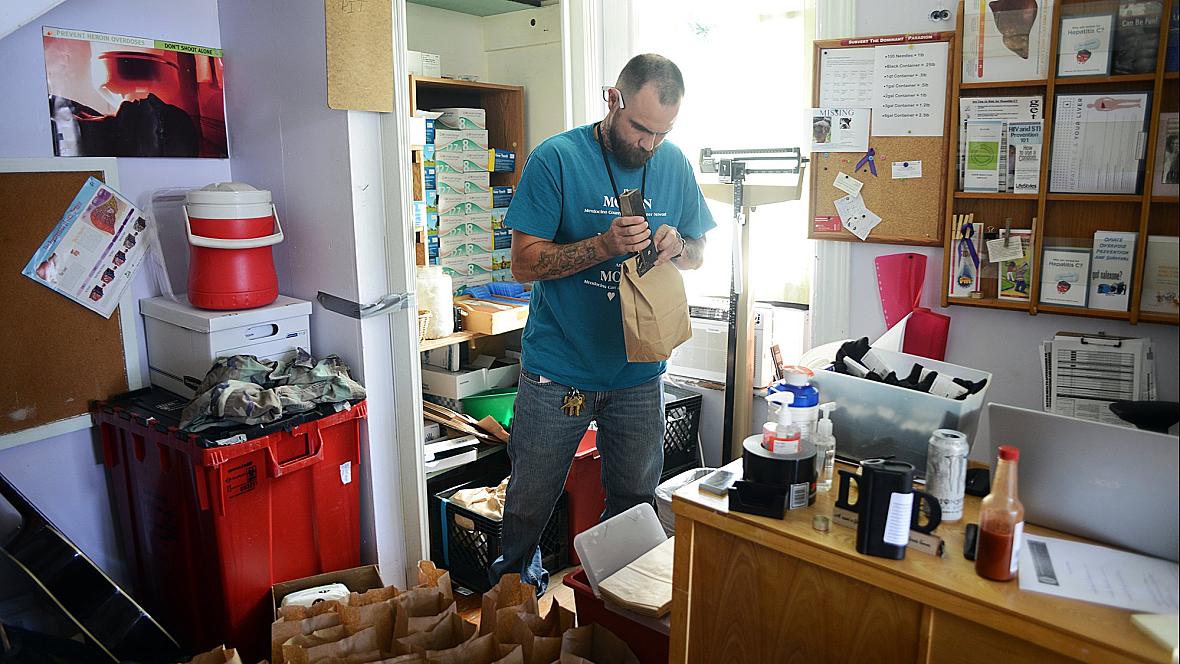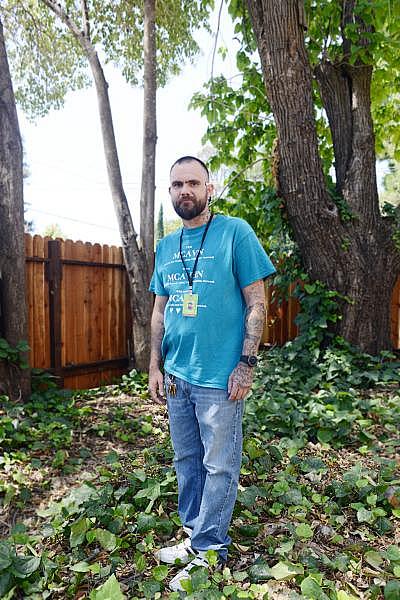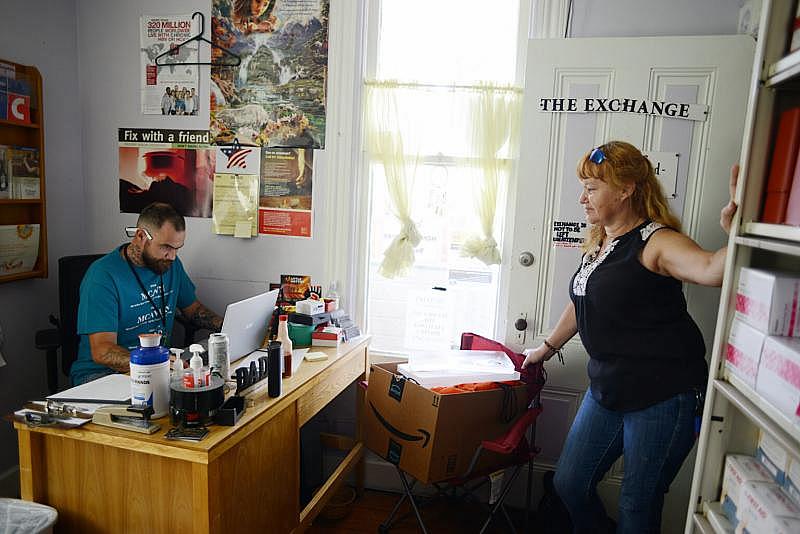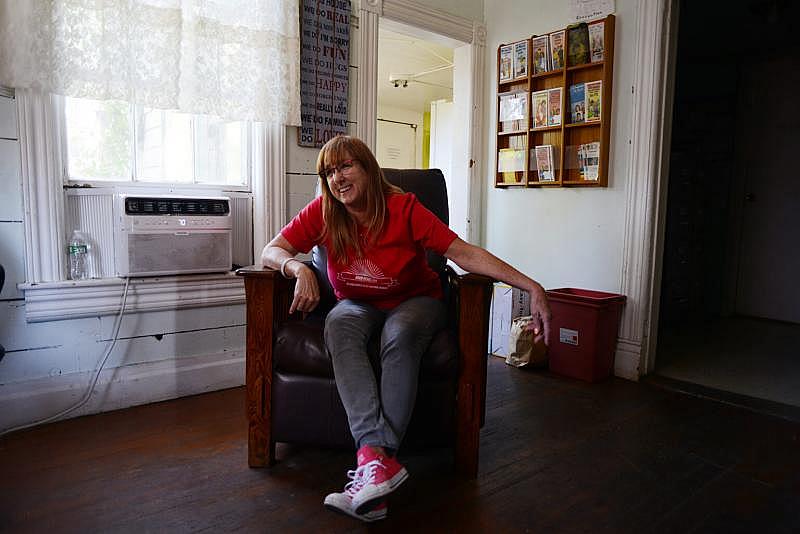Harm reduction models meet drug users 'where they’re at' and elicit more support as the opioid epidemic festers
This story is part of a larger story led by Dana Ullman, a 2021 California Fellow who is reporting on disparities in the quality and access to health care for Latino and Indigenous peoples in Mendocino County.
Her other stories include:
In Covelo, COVID clinics expand to reach more communities across Mendo
Share your pregnancy story: have you recently had a baby or support someone who has?
A ‘silver lining:’ Promotores de Salud fill gaps in public health response through community trust
What’s in a harm reduction kit, anyway?
Our resource guide for harm reduction and drug treatment services in Mendocino County
Looking for light in the darkness: Addressing suicide in Mendocino County
For birthing parents on the Mendocino Coast, labor and delivery centers are a disappearing act

In recognition of International Overdose Awareness Day on August 31, The Mendocino Voice presents part one of a two part series on how Mendocino County is addressing the opioid epidemic during the pandemic and beyond. Click here for a resources list and more information on getting support services and treatment for substance use disorder in Mendocino County.
Ukiah, 8/31/21 — Shawn Horn has worked at the MCAVHN Care and Prevention Network drop-in center for the past eight months, the same place where he used to come for syringes. For every client who knocks on MCAVHN’s door, Horn has an empathetic ear and a big laugh that puts even the most stressed-out client at ease.
“You can’t wear a button-up shirt and a tie here. No one will feel comfortable,” Horn says. Of the several skull tattoos that line his arms, one reads “Loyalty” across its forehead. “I was raised to be loyal,” Horn explains. “Whatever I commit to, that’s what I’m loyal to.”
As a former drug dealer, Horn still has many of the same clients — but instead of selling them drugs, he now offers them harm reduction services and a pathway to recovery, if they choose. The paradox is not lost on him.
“I never thought I’d be working here,” Horn said. “I just wanted to give back to a community I felt that I had screwed over for so many years. I probably know 70% of the people who come through this door.”
Throughout the pandemic, the heart of harm reduction in Mendocino County steadily beat from MCAVHN’s office, an unassuming house on a side street in downtown Ukiah. The demand never stopped, and the clinic never shuttered. For 34 years, MCAVHN, previously known as Mendocino County AIDS/Viral Hepatitis Network, has been a lifeline for persons with HIV, viral hepatitis, mental illness, and active drug users seeking support. The clinic operates the only syringe exchange in Mendocino County.
Studies have shown that syringe programs are effective in the prevention of infection diseases, a major public health issue. One study of a New York City syringe exchange found a decrease in HIV and Hepatitis C (HCV) by as much as 66%. In addition to saving lives, analyses of the cost-effectiveness of syringe programs estimate that by expanding harm reduction services, millions of dollars would be saved in health-related costs for treating HIV/AIDS and HCV.
The opioid epidemic has reached a new level of crisis during the pandemic, prompting the federal government to take unprecedented action to prioritize harm reduction efforts in U.S. drug policy. According to the Centers for Disease Control and Prevention (CDC) preliminary statistics released in July of this year, 94,134 people died from overdoses in 2020, compared to 70,630 in 2019. It’s the highest annual number on record, and largest single-year percentage increase in the past two decades. In another historical first, Congress has appropriated $30 million specifically for evidence-based harm reduction services, such as syringe exchange programs.
A portrait of Shawn Horn outside MCAVHN's office on July 15, 2021. (Photo by Dana Ullman/ The Mendocino Voice)
Horn lines the floor with brown paper bags, filling them with clean syringes, cotton, sterilized water, cookers, naloxone and tourniquets – a lifesaving kit for needle and opioid users. [Read Shawn’s breakdown of a harm reduction kit here.]
“I’m the bottom man on the totem pole, but [his colleagues say] I have the most important job here because I see the most clients,” Horn says. “I see every client who comes to the door, and I try to make them feel comfortable. It’s got to be hard coming up here to get needles or get help. A lot of people know that I’ve been there – and I don’t look like a cop.”
Horn laughs, recalling the shocked expressions of clients he knew when he was a drug-dealer when he opened the door for them at MCAHVN. The initial shock sometimes turned into genuine interest in how he turned his life around, Horn says. “People were like, ‘Well, if you can do it, I can.’ And I was like ‘Yeah, if you need that support, let me know. I got ‘chu.’ I still got my street cred, I still see my friends out there, and I still get the same love that I got when I was dealing. I never lost that.”
Horn’s turning point came when Child Protective Services took his children away last year. He quit drugs and alcohol cold turkey. It took him almost eight months, and a myriad of support services — but he was determined to get his kids back, and he did it, even accepting that he has to “co-parent with the system,” he explains. He and his wife recently welcomed their fifth child. What surprised Horn was the new world he now moved through as a sober person.
“I’ve always wanted to be clean and sober,” Horn says. As a child, Horn thought meth labs were just part of the environment. “I didn’t know any other life existed. I grew up in an alcoholic biker family. Everybody was a convict. At a young age I wasn’t taught to go to school, I was taught ‘Look, you’re going to be in prison at some point in your life, so you need to be ready for that.’ I was being prepped for that kind of stuff, not for getting a job.”
In California, overdose deaths have increased by 46.7% since the pandemic began. Mendocino County ranks fourth in the state in fatal opioid overdoses, according to 2020 preliminary data from the California Opioid Overdose Dashboard. According to the dashboard, people under 34 years old represent the majority of overdose deaths. Since January 2020, there have been at least 82 fatal overdoses countywide, according to the Mendocino County Sheriff and Coroner’s Office.
Drug overdoses, fatal and non-fatal, remain underreported. Libby Guthrie, executive director of MCAVHN, says this is due in part to a lack of fluidity in data sharing – incomplete death records, unreported overdoses and a significant delay in reporting all contribute to the lack of data. “We have seen hundreds of overdoses over the pandemic. We know a person who dies from an overdose just about every week,” Guthrie says.
Patti Parker, an outreach and harm reduction service provider, checks in with Shawn Horn before heading out to do outreach in Ukiah on July 15, 2021. (Photo by Dana Ullman/ The Mendocino Voice)
Decades of failed U.S. policy on drug use, a.k.a “the war on drugs,” attempted to enforce abstinence through criminalization, disproportionately incarcerating communities of color. For the past fifty years, these policies have attached stigma not just to the person using drugs, but also to those who provide harm reduction services.
Harm reduction is a set of principles rather than a universally defined program. Accepting drug use as a given, these principles put the focus on reducing the harmful effects of drug use using a variety of methods to address why a person uses drugs. Beyond syringe exchanges and treatment for substance use disorders, harm reduction programs connect clients with wrap-around services such as housing support and therapy.
Not everyone accepts this approach, and offering syringes rather than promoting abstinence has been controversial. Horn says this has given MCAHVN a reputation as “the bastards of Mendocino County.” This is in part due to a lack of understanding about what harm reduction is.
Illustrating this was a 2019 assessment report on opioid response planning in the South Coast by Mendonoma Health Alliance. Respondents ranked harm reduction services as the least useful approach to address drug use in their community. One respondent called harm reduction “just a crutch.” A Mendocino County Sheriff’s Deputy interviewed said “It’s best to keep people safe, but I’m not sure I completely agree with some of the practices used that involve handing people tools for drug use.” In 2019, the Mendocino County Sheriff’s Office began equipping officers and jail staff with Narcan, a life-saving medication that can reverse an overdose from opioids.
But MCAVHN’s staff and volunteers doing direct outreach say their work is curbing the spread of disease and showing up for people who are considering getting help, often giving them a second, third, even fourth chance at treatment. “Are they not considered human until they go into recovery?” asks Guthrie. “Someone who is an active user is still a human being who has needs. We see their humanity. If they slip, we have unconditional positive regard for them. That’s it.”
Libby Guthrie en la oficina de MCAVHN el 15 de julio de 2021.
Nationally, as drug overdoses hit an all-time high, there has been a sea change in how addiction is being addressed in the United States. The very harm reduction models MCAVHN has long employed and advocated for, in spite of the stigma attached to drug use, have been gaining support from historically resistant institutions – most recently from the federal government and the Mendocino County jail.
In May, the Biden Administration announced the American Rescue Plan, a $41.0 billion investment for national drug program agencies, including $705 million to support substance use disorder treatment (SUDT) in community health centers and in rural America, and $10.7 billion in funding to the Department of Health and Human Services to expand access to substance use prevention, treatment, harm reduction, and recovery support services, such as Medication Assisted Treatment programs.
In July of this year, Rhode Island became the first state to approve “supervised drug consumption centers,” and there is currently legislation proposed for similar programs in San Francisco, Oakland and Los Angeles County. Since the first supervised drug injection site was informally opened in the Netherlands in the 1970s, there are approximately 120 safe consumption centers operating in ten countries around the world including Canada, Australia and across the European Union. Studies have found positive impacts, including increased entry into treatment, reduced frequency of drug use, and a reduction in the transmission of infectious disease and drug-related overdoses.
In addition to the federal funds now allocated towards these kinds of substance use disorder services, the California State Legislature included $13 million in the 2021/2022 budget for the HIV/AIDS epidemic, sexually transmitted infections (STIs), viral hepatitis and overdose, and allotted an additional $3 million annually for the Syringe Exchange Supply Clearinghouse, which in part supports MCAHVN.
For a second year, MCAVHN received grant funding for a “low-barrier” Medication Assisted Treatment (MAT) clinic from the MAT Access Points Project, funded through the Department of Health Care Services and administered by the Center at Sierra Health Foundation. “Low-barrier means we meet you where you’re at. People can walk in from the street and with Medi-Cal, it’s covered,” Guthrie says.
MCAVHN offers a spectrum of harm reduction services beyond syringe exchange and MAT programs, including a Medication for Opioid Use Disorder (MOUD) programs, counseling, fentanyl drug testing strips, overdose prevention services and naloxone trainings, as well as naloxone. The clinic also provides housing services, Hepatitis C testing and treatment, HIV/AIDS testing and linkage to medical care, and Supplemental Security Income (SSI) advocacy services.
“We don’t push recovery, but the people who come here know they’re addicts,” says Horn. “A lot of people will say that we enable, but listen, when I was dealing drugs I looked at it as, ‘They’re gonna get it somewhere, might as well get it from me.’ They’re going to get needles somewhere. They’re going to get cottons somewhere. Whether it be a pack of cigarettes and you take out the cotton and roll it up … they’re going to get it somewhere. So why not give them a safer way to do it?”
Horn says the ultimate goal is to stop drug use, but the reality is that for many people, that won’t change any time soon. “Most times they’re coming for needles,” says Horn. “So we try to get them out as fast as we can. I know what it’s like to just want to get your shot and go. And get well. But people do come here and want to get clean and sober. And we can help.”
The physical isolation imposed by the pandemic has negatively impacted drug users and those in recovery across the county who could not access in-person services or support groups as they had pre-pandemic. And closed borders due to the pandemic caused the price of street drugs to soar, Horn adds. As a result of a drug shortage, meth and heroin are increasingly cut with fentanyl, a cheaper, synthetic drug up to 100 times more potent than morphine, which has flooded the drug market in Mendocino County in the last couple years. Horn says a new problem is Carfentanil, a tranquilizer used for large mammals like elephants. The synthetic opioid is 100 times more toxic than fentanyl.
For those providing support services, meeting patients in person was not feasible during lockdown. Dr. Lin Taylor, the case manager for Mendocino Coast Clinics’ MAT program, who hosts weekly support meetings for her patients in Fort Bragg, said the pandemic created the “perfect storm” for her patients to relapse.
Of her clients,Taylor said, “I did have quite a few relapses during the pandemic. They’re isolated. They’re anxious. They’re scared. They have no social responsibilities or anybody to check on them, and a lot of people lost their jobs. They were home and bored and didn’t know what to do with their emotions. It was a perfect storm.”
Taylor elaborated on the challenges that the pandemic brought.“I talked [to patients] over the phone, I texted them or, if I could, I did video, but a lot of people don’t have access to video,” she said.
Shawn Horn recoge y elimina de forma segura las jeringuillas usadas en Building Bridges, un centro de recursos para personas sin hogar en Ukiah, el 15 de julio de 2021. MCAVHN opera el único intercambio de jeringas en el Condado de Mendocino.
Back at MCAVHN, relationships that staff had been building with different communities became strained due to the pandemic lockdown. “Follow through is number one for people. If you don’t show up, you can be cut off like that,” Guthrie says, snapping her fingers. “We had momentum, but then the pandemic hit. We’ve struggled to reconnect.”
In the past year, Horn has provided 3,481 services to those who have knocked on MCAVHN’s door, mostly returning clients. From Gualala to Covelo, outreach teams traverse the county collecting used syringes and dispensing clean ones. Though the pandemic slowed MCAVHN’s work, the clinic never completely shut down services.
“Bottom line is, we figured out a way to treat people as humans and meet them where they’re at,” Guthrie says. “We won’t walk away. If we have to do it from a station wagon down the street, we’ll still be here.”
Stayed tuned for our next article, which looks at how opioid use is being addressed in the Mendocino County jail through Medication-Assisted Treatment programs.
Dana Ullman reports on health-related stories for The Mendocino Voice with support from the USC Annenberg Center for Health Journalism. This article was produced as a series for the 2021 Center for Health Journalism California Fellowship.
[This story was originally published by The Mendocino Voice].
